The day when Bertox lures appear in fishing stores in the countries, which are lucky to have access to the sea, is considered to be a holiday for anglers fond of spin fishing. High manufacturing quality and catch efficiency are the main reasons for that.
If you set the goal of finding out where Bertox lures come from using Internet search engines, you can wrack your brain, since at first, they seem to have their origins in Zagreb, then they proceed to Italy, then to tropical countries, where the traces are lost. All that remains are photos of tuna, GT, and other predators caught with Bertox lures.
It’s hard to assume that Bertox is from Belgrade, Serbia, and these soft plastic lures, stickbaits, and poppers, which are also known in New Zealand, are produced by the fisherman who doesn’t live by the sea, Draško Klačar.
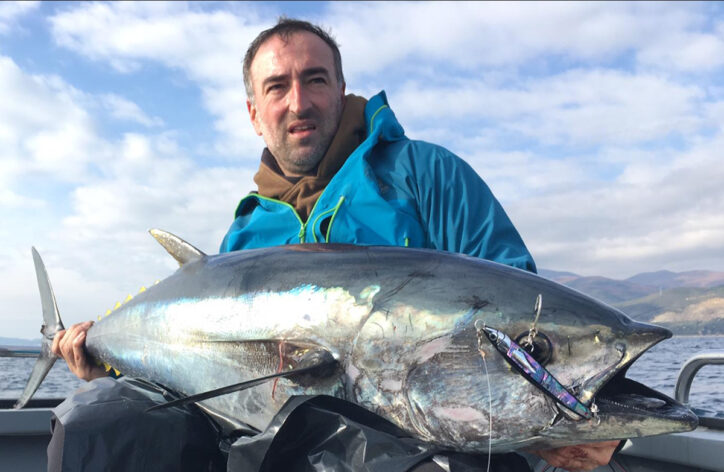
(Draško Klačar with a bluefin tuna caught with Bertox stickbait. Photo © Draško Klačar)
What’s easy with Draško: text him on Facebook, then call more than once on the phone, asking any questions you’re interested in and getting comprehensive answers to any of the questions asked.
What’s difficult, or rather almost impossible: once in Belgrade, fail to have a cup of coffee with Draško, fail to receive sticks, poppers, or soft plastic lures as a gift, and try to pay the bill for what you’ve drunk. Arrange an interview.
Draško is probably modest and very busy. He hardly ever talks to anyone on the pages of fishing magazines and Internet resources. Our conversation is one of the few with the “public” Draško Klačar.

(GT caught with Bertox popper. Photo © Draško Klačar)
Hello, Draško! Thanks for taking the time to talk. How come you started producing the lures for fishing on the sea while being on the banks of the beautiful freshwater Danube?
I started fishing on the sea as a child with my late father near the island of Ada Bojana in Montenegro. Since I was a kid, I’ve tasted sea salt on my lips. When I was about 14, I went fishing all alone in the same place and caught my first personal trophy.
Since childhood, I’ve been catching sea bass at the mouth of the Bojana River. As children, we saw leerfish for the first time there. At that time we had absolutely no understanding and experience of how to catch them. Sea bass acted much like our “local” pike-perch from the Danube. In those days, I already made my own soft plastic lures for catching them, which I later used for catching seabass in Bojana.
As the years passed, I spent more and more time on Bojana, gradually improving the lures. Eventually, Bertox soft plastic lures became more and more suitable for fishing on the sea.

(Bertox lures in action. Photo © Draško Klačar)
Why is your company called Bertox?
Some time ago I met a colleague from Sweden. At that time, he made jerk baits for pike fishing. They were simply amazing! Bertox was the name he called his baits back then. I really liked that name, so I decided to immortalize it.
Let’s talk about Bertox soft plastic lures. How did you realize that the shapes, weights, and sizes that we see in stores today are exactly what sea bass, bonito, tuna, and other inhabitants of the oceans need? Does animation for your soft plastic lures have any peculiarities?
The lure retrieve depends on the specific situation and the experience of the angler. Bertox lures are a product of personal experience. Every lure on the market has at least survived my rigorous elimination process and is great for fishing under the conditions it was designed for. Today, Bertox offers two types of soft plastic lures, including Sea Bass Candy, aimed primarily at catching sea bass, and Natural Sardine, which is designed for catching tuna and other large pelagic predators.

(Bluefin tuna caught with “Natural Sardine”. Photo © Draško Klačar)
Should anglers pay so much attention to the color of soft plastic lures?
The choice of lure color depends on various characteristics of water while fishing. Although it’s not always the color that is decisive. Anglers often get used to the colors of the lures they caught fish with. And that’s great because when you’re confident in what you’re doing, it brings results.
Your stickbaits and poppers are masterpieces. Please tell us about them. What materials do you use to make them? What models do you offer anglers now? In what situations are they irreplaceable?
Stickbaits and poppers are made of abachi (African whitewood). The balancing of each lure is individual. We use the highest quality epoxy and polyurethane resins in our production.
At first, I test each model myself. Then, I send it for testing to my colleagues – great fishermen and friends. So, the lures are perfect in the end. If not, then I strive for perfection. Stickbaits and poppers are must-haves for fishing on tropical seas, as well as for tuna fishing.
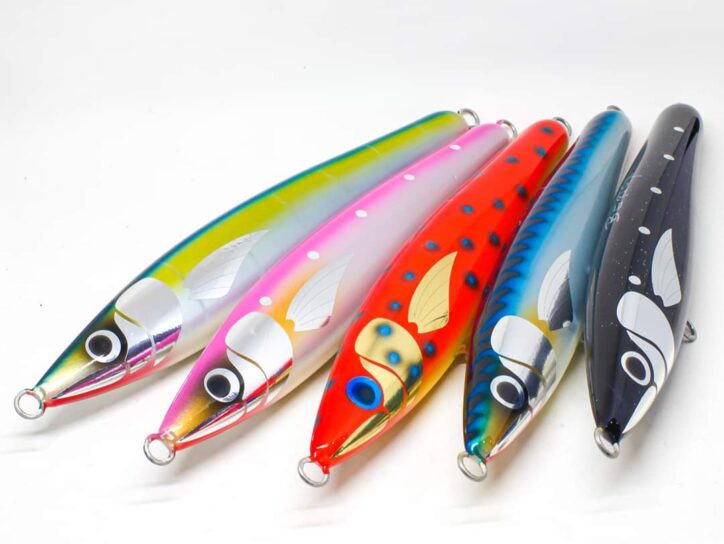
(Bertox stickbaits. Photo © Draško Klačar)
Are the stickbaits you offer to anglers designed for offshore fishing? Or can they be used for shore fishing?
Of course, they can be used for shore fishing as well. Almost all serious predators can be caught with them.
How to choose the right size and weight of your stickbaits depending on the situation?
It really depends on the situation in which you use them. The stick is a lure for the mature and experienced angler. It takes experience to fish with it as intended. Of course, you can fish with such lures “to the touch”, but in order to feel how to animate them and how to use them in certain conditions, a lot of water should flow under your feet.
The angler should understand which tackle to choose for a particular situation, how to animate the lure. While fishing with poppers requires a rod with a stiff top, you need to have a rod or several rods (I use 4 different models) with a conditionally softer so-called rod top to use sticks.

(Little tunny caught with Bertox stickbait. Photo © Draško Klačar)
What can you say aboutchoosingthe color of stickbaits?
“Mediterranean” colors are mostly of natural shades. Based on my ten years of experience, both bright and natural colors are suitable for fishing on tropical seas. The lures should be big, that’s it.
Please tell us about your experience in catching bluefin tuna with Bertox lures in the Adriatic Sea. Soft plastic lures, poppers, or stickbaits? When and in what situations?
I’ve had the most productive fishing in Greece. I’ve had less success in Montenegro. I’ve caught several great tuna in Croatia. However, I’ve rarely caught fish in Croatian waters, which are abundant in bluefin.
The choice of the lure depends on the food supply that tuna is interested in at the moment. If it chases small anchovies or sardines, then soft plastic lures or small sticks are the right choices. If tuna chases large fish, which is the most favorable situation for anglers trying to catch tuna, large stickbaits and poppers are the best solutions.
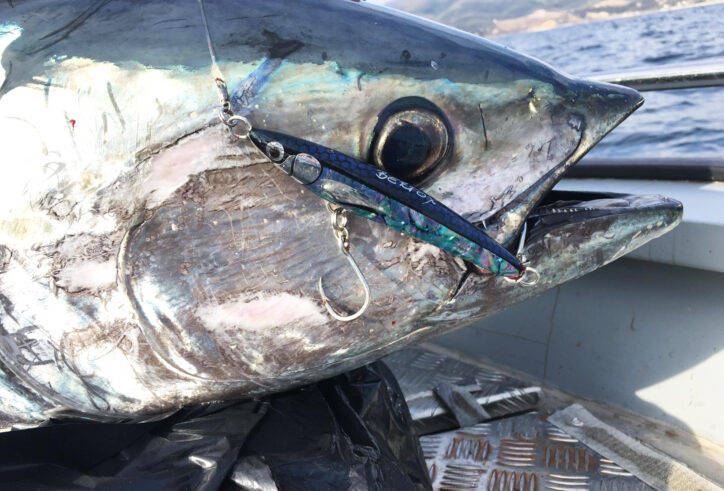
(Bluefin tuna caught with Bertox stickbait. Photo © Draško Klačar)
How do other large predators of the Mediterranean Sea such as amberjack, leerfish, swordfish, and mahi–mahi react to your lures?
“Natural Sardine” is a lure with which I started experimenting with catching leerfish 30 years ago. Almost all predators can be caught with this lure.
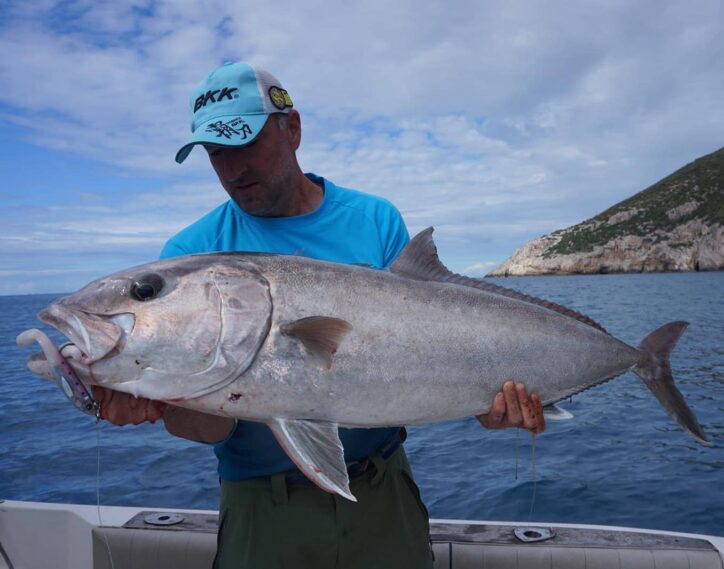
(Greater amberjack caught with “Natural Sardine”. Photo © Draško Klačar)
On which seas do you like to test your lures more? What trips and fish species caught with Bertox lures were the most impressive?
I test my lures whenever I go to sea fishing.
It’s hard to choose between tuna fishing in the Mediterranean Sea and catching tropical fish. There’s no way I can choose one. Perhaps, fishing on tropical seas is more intense.
But the atmosphere of fishing and a crazy fish that wants to throw you off the deck of the boat (when you fish with a tight reel drag) neutralizes the difference.
However, if I still have to answer the question about my favorite fish species, then probably my favorite predator is GT, giant trevally.
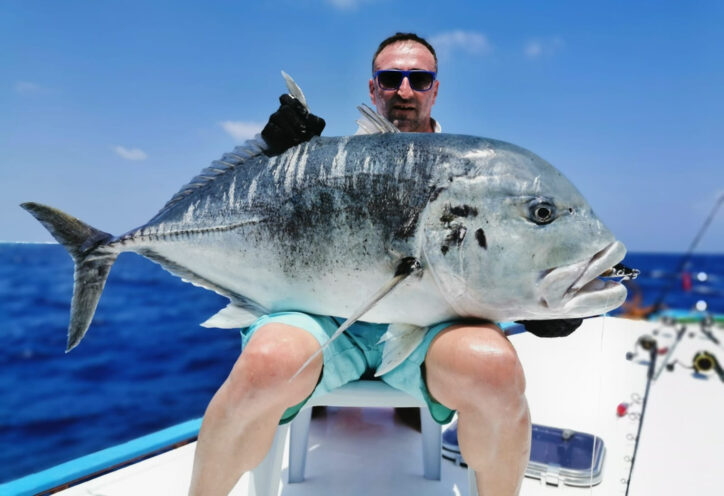
(GT caught with Bertox stickbait. Photo © Draško Klačar)
You make lures for freshwater as well. Please say a few words about them.
I’ve been catching pike-perch with my own soft plastic lures nearly all my fishing life. It may sound pretentious, but I’ve tried all sorts of alternatives and haven’t found a better one than my soft plastic shad, which I use to catch pike perch to this day.
I started making vibe lures about twenty years ago. At that time, vibes were still unknown on our water bodies. These are versatile lures, with which almost any freshwater predator can be caught. In particular, they’ve proven to be perfect for catching catfish.
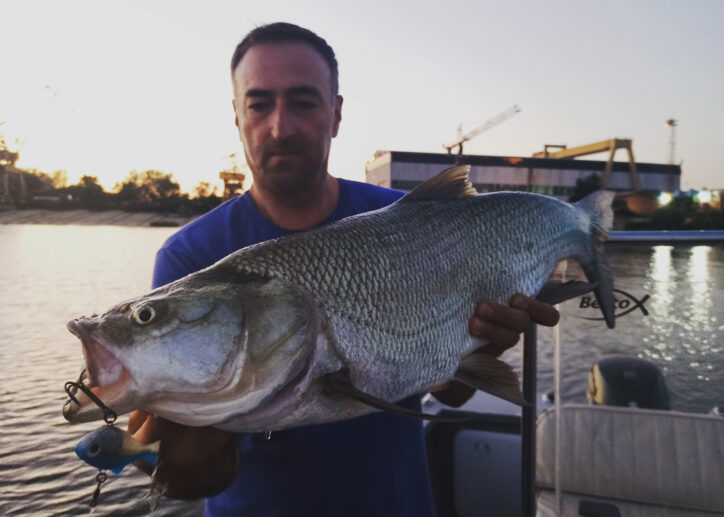
(Asp caught with Bertox soft plastic vibe. Photo © Draško Klačar)
What can you wish adriaticnature readers today?
For now, the only thing I can wish is the coronavirus sh*t to stop, and for people to be free to travel, communicate, and enjoy life.
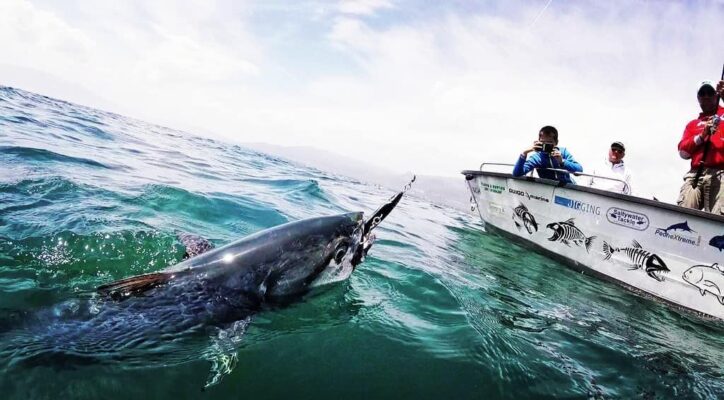
(Bluefin tuna caught with Bertox stickbait. Photo © Draško Klačar)